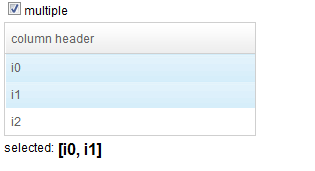MultipleSelectAgent
Multiple Select
The reason that ZATS Mimic provides a MultipleSelectAgent instead of combining it with the SelectAgent is to avoid confusion making it clearer to distinguish each action. As it is possible for an user to perform single selection in a listbox with attribute "multiple=true", If we only have one agent to select, it is hard to tell which kind of selecting a tester is referring to. Therefore, we designed two separate agents to reflect a tester's intention more precisely. With MultipleSelectAgent , you can select() and deselect() . This operation can only be used on listitem and treeitem.
The application we use to demonstrate this usage contains a listbox with attribute "multiple=true" at first and there is also a checkbox that can switch the listbox between single and multiple selection mode. When we select one or more items, the label at the bottom will display all selected item's label.
In the test case below, we perform three different tests;
- multiple select in multiple selection mode
- single select in multiple selection mode
- multiple select in single selection mode
MultipleSelectTest
@Test
public void testAgent() {
DesktopAgent desktopAgent = Zats.newClient().connect("/multiple-select.zul");
Label msg = desktopAgent.query("#msg").as(Label.class);
Assert.assertEquals("", msg.getValue());
ComponentAgent listbox = desktopAgent.query("#lb");
Assert.assertEquals(4, listbox.as(Listbox.class).getChildren().size()); // include header
List<ComponentAgent> items = listbox.queryAll("listitem");
// listbox multiple selection
items.get(0).as(MultipleSelectAgent.class).select();
items.get(1).as(MultipleSelectAgent.class).select();
items.get(2).as(MultipleSelectAgent.class).select();
Assert.assertEquals("[i0, i1, i2]", msg.getValue());
Assert.assertEquals(3, listbox.as(Listbox.class).getSelectedCount());
items.get(1).as(MultipleSelectAgent.class).deselect();
Assert.assertEquals("[i0, i2]", msg.getValue());
Assert.assertEquals(2, listbox.as(Listbox.class).getSelectedCount());
items.get(0).as(MultipleSelectAgent.class).deselect();
Assert.assertEquals("[i2]", msg.getValue());
Assert.assertEquals(1, listbox.as(Listbox.class).getSelectedCount());
items.get(0).as(MultipleSelectAgent.class).deselect(); // should happen nothing
Assert.assertEquals("[i2]", msg.getValue());
Assert.assertEquals(1, listbox.as(Listbox.class).getSelectedCount());
//single select in multiple selection mode
String[] values = { "[i0]", "[i1]", "[i2]" };
for (int i = 0; i < 3; ++i) {
items.get(i).as(SelectAgent.class).select();
Assert.assertEquals(values[i], msg.getValue());
}
//multiple select in single selection mode, throw an exception
desktopAgent.query("#multipleMode").as(CheckAgent.class).check(false);
try {
items.get(0).as(MultipleSelectAgent.class).select();
Assert.fail();
}catch(RuntimeException e){
System.out.println(e.getMessage());
}
}
- With
MultipleSelectAgent, we can mimic multiple selecting behavior. (line 13, 19)
- Deselect a non-selected item won't cause any error. (line 26)
- Under multiple selection mode, you can still use
SelectAgentto perform single selecting. (line 33)
- But if you want to do multiple selecting under single selecting mode, you'll get a run-time exception. (line 40)
Supported Components
| Listitem, Treeitem | 5, 6 |
